Services offered by the Fort York Guard
Introduction
The history of the Fort York Guard goes back to the 1930's when the Fort was restored as a make work project during the depression. The guard was in it's peak during the 70's and 80's, with ever increasing numbers, when the program got cancelled due to a black powder accident. Recently, in 1995, the guard was reinstituted, and since that time it has fluctuated in size while trying to find the right balance of leadership and membership.
In 2001 the guard underwent perhaps it's biggest change yet, when it split into two sub-divisions: The squad and the drums. The squad is the group of people who perform the military arms drill, and the drums are the period musicians.
The following sections have pictures and descriptions of the various demonstrations. Click on any of the pictures to enlarge them in a seperate window. They will all open in the same window, no multiple windows will open.
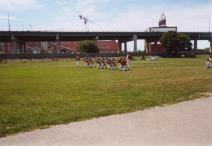
Musket Demonstrations
The musket demonstrations are performed by the squad twice each day. The squad commander will assemble the soldiers, perform an inspection exercise, then march the soldiers to the parade square. When there, they will perform various musket maneuvers, which may include the following:
- Platoon loading exercise: This involves loading the musket at practice speed, not battle speed. All steps of the loading exercise are performed in unison.
- Firings exercise: Similar to the platoon loading exercise, but all steps are donw as fast as the soldier is capable, as it would be in battle. Soldiers load at their individual speed, so any unison is purely coincidental.
- Light infantry exercises: Like the first two listed here, this is an exercise in loading the musket. Unlike them, however, this involves the soldier loading the musket while down on one knee, and extended from the other soldiers.
- Volley firing: When firing a volley, all soldiers pull the trigger at the same time. If done correctly, there should be one loud report from the entire section. This was the main battlefield tactic at the time: throw as much lead at the enemy as possible.
- Firing by file: Unlike a volley, when firing by file the soldiers pull the trigger so the firing commences down the line with one soldier firing, then the next, then the next, and so on. If the number of soldiers is sufficiently large there can be continous fire for as long as the ammunition holds out.
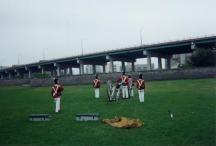
Artilery Demonstration
The artilery demonstartions are also performed twice each day by the squad and the drums. The artilery piece (called a gun not a cannon, cannons were on ships) requires a gun crew of at least three gunners and one gun commander. The steps in loading the gun are quite extensive for safety reasons. A description of the loading procedure follows this paragraph.
- Hook piece: A metal wurm is sent down the barrel of the gun, with the intention of the tines hooking into any debris left in the barrel.
- Brush piece: A wire brush is sent down the barrel of the gun to exsitguish any sparks that may remain in the barrel.
- Drift vent: A smaller wire brush is sent down the vent (the opening in the back of the gun where the fuse is placed) by the ventsman to make sure it is clear of debris.
- Tend vent: The ventsman (with a leather thumb cover called a thumb stall) places his/her thumb over the vent. This step is better explained in the next command.
- Advance sponge: A sheepskin sponge is dipped in a bucket of water and wrung out thoroughly.
- Sponge piece: This sponge is then sent down the barrel to make extra sure no sparks exist. Because the vent is covered, a vacuum is created in the barrel making it impossible for sparks to continue burning.
- Handle cartridge: A foil cartridge containing black powder is retrieved from a gun box placed a distance from the gun. This is then given to the gunner standing to the left of the muzzle.
- Load: The cartridge is taken and placed in the muzzle of the gun
- Ram down cartrige: On the revers end of the sponge there is a blunt end used to push the cartrige down the barrel. This is the most dangerous part of loading the gun. The rammer stands with his/her body totally behind the muzzel holding the rammer in two fingers.
- Prime: The ventsman removes his/her thumb from the vent hole and uses a priming wire to prick a hole in the foil cartridge. If the cartridge is in place and the hole has been pricked, the ventsman shouts "Home!" to indicate to the commander that everything is normal. If not, the ventsman will shout "Not home!" and the commander will then have to take action to secure the piece.
- 5 advance: On this command, the number 5 gunner (on a four gunner crew with a commander) advances with a lindstock (a piece of slow match that is lit at one end) which is used to fire the gun.
- Fire: The slow match is touched to the fuse, and the gun has now been fired once.
- Hook piece: This step will hook out the remaining foil from the previous firing. The front end of the cartridge will be blown out of the barrel, while the back end remains.
- Brush piece: This will remove any sparks remaining in the barrel.
- Drift vent: All these commands must be performed twice to make sure the gun is secure again.
- Tend vent: Performed as before.
- Advance sponge: Performed as before, except the sponge may not need to be rewetted.
- Sponge piece: Performed as before. After this step, the sponger shouts "Gun is secure!" The piece has now been secured, and needs no further steps to make it safe.
- Cease firing: If no other firing is required, the gun can now be left unattended.
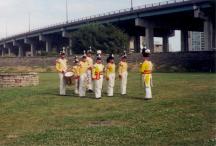
Music Demonstration
The music demonstration is performed once a day, 5 days a week, by the drums and usually a few members of the guard. The word "drums" means all the musicians who played the fife or the drum. The music played is all historic with popular tunes and historic beatings.
The fife played by the Fort York Guard is a 6-holed, side-blown, wooden fife. The drum played is a rope-tensioned, side-slung, tenor snare drum. During the War of 1812 the musicians had three very important roles.
- Duty calls: These tunes and beatings were used to regulate a soldiers day. They told the soldier what to do, and at what time. Everything from waking up to going to bed, lunch time to the end of the work day, could be signalled by the drums. Some examples of duty calls are:
- Reveille - tune used to wake the soldiers up
- Dinner Call - The Roast Beef of Old England - indicates lunch time
- A Retreat - signals the end of the work day
- Church and Recruiting Call - used to call soldiers to church, or used by recruiting parties
- Popular music: This set of music included all the popular music of the day. It was mostly used for moral; playing songs the soldiers could listen to or sing along on long marches. Without this, marches would be extremely long and tedious. Some of the most popular music of the day included:
- British Grenediers' March - A song comparing the British army to such immortal heroes as Hercules and Alexander the Great
- The Girl I Left Behind Me - A song about leaving your home and your girlfriend or wife behind
- Turkish March - At this time Turkish things were extremely popular and trendy. This song is Turkish-sounding, and very popular for the day
- Formal music: The final set of music were formal songs without lyrics (so soldiers wouldn't sing along) that was played during formal occasions. Such occasions could be inspections by a high ranking officers, visiting royalty, or any other occasion where playing popular, common, songs would be inappropriate.
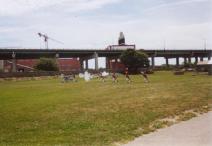
Military Show
The military show only takes place, full-scale, three times a week. It involves all of the guard; both the squad and the drums. This show is meant to show all aspects that the guard portrays at the same time. The schedule of the show is somewhat as follows:
- Drums march on - The drums march past the audience, and on to the parade square. They are in full formation and playing music at this point.
- Drums perfrom show - The drums put on their show, displaying a variety of maneuvers and formations, and playing many sets of tunes. They play popular tunes, dances, formal tunes, and fife solos.
- Drums march off - After the drums have put on thier show, they march off the parade square, still playing music.
- First squad marches on - The first squad of soldiers marches onto the parade square at the same time as the drums are marching off.
- First squad performs show - The first squad begins to perform light infantry exercises against the invisible foe. They fire several rounds before closing up.
- Artilery doubles on - The artilery crew (manned by the drums) doubles in (running in unison) and begins to load the artilery. This occurs while the first squad is still performing light infantry.
- Second squad quick marches on - The second squad quick marches in as the first squad is closing up. They join in the formation, forming one squad.
- Artilery crew fires - The drums fire the gun as the squads are joining together.
- Squad commences firing - The entire squad commences in line firing. A variety of firing types are used including volley, and file firing.
- Final Volley - Both the drums (on the gun), and the squad fire one final volley in unison.
- Bayonet charge - The squad fixes bayonets and does a bayonet charge across the parade square. The drums are securing the gun at this point.
- Drums quick march to squad - The drums, having secured the gun, quick march across the field and join formation with the squad.
- March past the audience - The combined guard then marches past the audience, and the show closes.
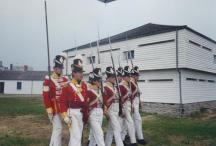
Soldier's Drill
Prehaps not the most exciting demonstration to watch, but certainly the most important part of a soldiers day when garrisoned in a fort. Both the squad and the drums take this chance to train their soldiers. The squad may be working on a new maneuver or perfecting an old one, while the drums may be learning or practicing a new piece, or practicing foot drill. It is in interesting demonstration to watch, because both the squad and drums are training at the same time, but independent of each other. There is usually much to see during this time.
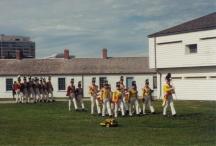
Flag Parades
The first and last parade of each day is a flag parade. In the morning the flag is rasied, and in the afternoon the flag is lowered. These parades involve the full guard, both squad and drums. As the guard marches out, the drums play music to help keep the soldiers in step. While the flag party is raising or lowering the flag, the drums play "God Save the King" (there was a king during the War of 1812). There are also a couple of other tunes that are involved in the ceremony, then the guard marches back.






